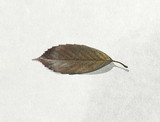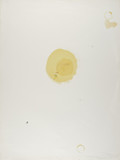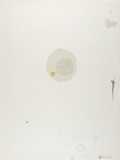Conceptual printmaker and draughtsman; used mixed media techniques to create paper sculptures; mixed traditional printing techniques and exploited his supports, often printing on both sides of the paper; solo shows internationally from 1970.
Experimented with lithography, silkscreen and oil painting. In 1965, graduated from Kyoto City University of Arts (Kyoto Shiritsu Bijutsu Daigaku), specializing in Western-style painting. Studied print-making independently. Moved from woodblock prints and etching to lithography and silkscreen, and then to works that combine several techniques with offset printing. In 1968, won first prize at the third Mainichi Concours for Study in France (Mainichi Furansu Ryugaku Konkuru). Thereafter won awards for work submitted to international biennale exhibitions in Tokyo, Paris, Crakow, and Ljubljana. In 1975, won an Award of Excellence at the first Modern Japanese Print Exhibition, and in 1976 won the Minister of Culture Prize at the tenth International Tokyo Print Biennale. Notable works include "Pink Mama" (lithograph, 1966), "Dance on the Grass" (silkscreen, 1971), "Conception" (lithograph, silkscreen and offset printing, 1974), "Surface is the Between" (lithograph series, 1978 onward), and "Onto the table and on the paper no. 3" (lithograph, 1981). - British Museum https://research.britishmuseum.org/research/search_the_collection_databa...
Sources: http://www.bellasartesgallery.com/ida_bio.html and as footnoted.
Shoichi Ida, who has lived, worked and exhibited internationally throughout his career, has chosen to remain in the traditional Japanese city of Kyoto where he was born in 1941. He earned a postgraduate degree from the Oil Painting Department of Kyoto Municipal University of Art in 1965. He received a grant in 1968 from the French government to live and work in Paris and also lived briefly in New York and in San Francisco.
Among his many awards are the Award For Excellence in International Cultural Exchange from the National Endowment for the Arts presented to him and Robert Rauschenberg in 1986 and the prestigious Suntory Prize in Japan awarded to him in 1989.
During his career he taught at the Kyoto Municipal University of Art and lectured widely in Japan and abroad.
Best known for his paper works and prints, Ida has worked with a variety of media from painting, drawing, ceramics, metal, stone and cloth to environmental and installation art. Ida's art involves a melding of Eastern traditions with a truth to materials common to Western Minimalism. The link between the two is nature. Ida has for many years worked on a series titled Surface is the Between which he explained in an interview published in the Hara Museum Review Spring 1987.
The "Surface" can be the paper or canvas or whatever, it is the point of contact between me and the ideas I am working on or the other materials I am working with. Or, an easier way to understand this might be to say that while we are talking now, there is a space between us where communication takes place. That space is important to appreciate — but you can't really see it, it's just air. You can't see the wind either, but if you look at the branches of a tree moving you can see the force of the wind. Through my work I try to make invisible phenomena visible by showing the point of contact.
In many respects, Ida’s abstract, mixed media prints fit in well with some of the more advanced, minimalist work being done in Europe and America, yet in other respects – in their sensitive utilization of handmade paper, for instance – they are very much a part of the Japanese tradition, where they easily take their place beside the work of Onchi and Kosaka Gajin.
A friend of artists Carl Andre and Robert Rauschenburg, Ida was in rapport with the cutting edge of Western Contemporary dialog. He had met John Cage and loved the effects of chance, particularly the unpredictable results of naturally occurring processes. From the time of his earliest works he also admired Duchamps and word play.
Ida passed away in 2006 after a long bout with cancer.





